Study on the Sedimentary Environments and Its Implications of Shale Reservoirs for Permian Longtan Formation in the Southeast Sichuan Basin
(This article belongs to the Section Mineral Exploration Methods and Applications)
Abstract
1. Introduction
2. Geological Background and Experiments
3. Results
3.1. Thin-Section Observations
3.2. Petrology and Characteristics of Different Lithological Combinations
3.3. Geochemical Characteristics
3.4. Pore System of Shale Reservoir
3.4.1. Pore Type
3.4.2. Pore Structure
4. Discussion
4.1. Sedimentary Environments and Sedimentary Facies
4.2. Shale Reservoir Quality in Different Sedimentary Facies
5. Conclusions
- (1)
- The Longtan Formation in the southeast Sichuan Basin was deposited in complex marine–continental transitional environments, and the sedimentary facies varied from delta and shore swamp to mixed tidal flat and shallow shelf facies. The lithological combinations also varied greatly vertically, and the most favorable sedimentary environments for shale deposition were shore swamps and tidal flats. The shale in the shore swamp and tidal flat facies had high TOC contents and a good pore structure.
- (2)
- The sedimentary environments determined the organic matter accumulation and TOC content. The TOC of shale in the shore swamp facies was much higher than that in the mixed tidal flat and shallow shelf facies. All of the shale samples were in a high-maturity stage. The accumulation of organic matter was affected most by the detrital input and water depth.
- (3)
- There were several lithological combinations present in various sedimentary environments. The mineral compositions of the Longtan Formation varied frequently in different sedimentary facies. The pore system of the Longtan shale consisted of inorganic pores with a small number of organic pores and microfractures. The pore structures in the shore swamp and shallow shelf facies were well developed. The Longtan shale—with a large continuous thickness, good pore system, and high gas content—will be the most favorable shale exploration target in the future.
Author Contributions
Funding
Data Availability Statement
Acknowledgments
Conflicts of Interest
References
- Potter, C.J. Paleozoic shale gas resources in the Sichuan Basin, China. AAPG Bull. 2018, 102, 987–1009. [Google Scholar] [CrossRef]
- Yang, H.; Lin, L.; Chen, L.; Yu, Y.; Li, D.; Tian, J.; Zhou, W.; He, J. Characteristics of Mineralogy, Lithofacies of Fine-Grained Sediments and Their Relationship with Sedimentary Environment: Example from the Upper Permian Longtan Formation in the Sichuan Basin. Energies 2021, 14, 3662. [Google Scholar] [CrossRef]
- Krooss, B.V.; Van Bergen, F.; Gensterblum, Y.; Siemons, N.; Pagnier, H.J.M.; David, P. High-pressure methane and carbon dioxide adsorption on dry and moisture-equilibrated Pennsylvanian coals. Int. J. Coal Geol. 2002, 2, 69–92. [Google Scholar] [CrossRef]
- Clarkson, C.R.; Solano, N.; Bustin, R.M.; Bustin, A.M.M.; Chalmers, G.R.; He, L.; Melnichenko, Y.B.; Radliński, A.P.; Blach, T.P. Pore structure characterization of North American shale gas reservoirs using USANS/SANS, gas adsorption, and mercury intrusion. Fuel 2013, 3, 606–616. [Google Scholar] [CrossRef]
- Cao, T.T.; Deng, M.; Song, Z.; Luo, H.; Hursthouse, A.S. Characteristics and controlling factors of pore structure of the Permian shale in southern Anhui province, East China. J. Nat. Gas Sci. Eng. 2018, 60, 228–245. [Google Scholar] [CrossRef]
- He, J.H.; Deng, H.C.; Ma, R.L.; Wang, R.Y.; Wang, Y.Y.; Li, A. Reservoir characteristics of the Lower Jurassic lacustrine shale in the Eastern Sichuan Basin and its effect on gas properties: An integrated approach. Energies 2020, 13, 4495. [Google Scholar] [CrossRef]
- Kuang, L.C.; Dong, D.Z.; He, W.Y. Geological characteristics and development potential of transitional shale gas in the east margin of the Ordos Basin, NW China. Pet. Explor. Dev. 2020, 47, 435–446. [Google Scholar] [CrossRef]
- Ko, L.T.; Loucks, R.G.; Zhang, T. Pore and pore network evolution of Upper Cretaceous Boquillas (Eagle Ford–equivalent) mudrocks: Results from gold tube pyrolysis experiments. AAPG Bull. 2016, 100, 1693–1722. [Google Scholar] [CrossRef]
- Zhao, W.; Wen, Z.; Zhang, H.; Wu, C.; Liu, Y.; Song, H.; Zhang, L.; Xi, Y.; Sun, L. Integrated Assessment of Marine-Continental Transitional Facies Shale Gas of the Carboniferous Benxi Formation in the Eastern Ordos Basin. Energies 2021, 14, 8500. [Google Scholar] [CrossRef]
- Jin, L.; Wang, X.J.; Zhou, K. Characteristics of ultra-deep shale reservoir of continental-marine transitional facies: A case study of lower member of Upper Permian Longtan Formation in well Y4, Puguang Gas Field, northeastern Sichuan Basin. Pet. Explor. Dev. 2022, 44, 71–84. [Google Scholar]
- Xu, H.; Zhou, W.; Zhang, R.; Liu, S.M.; Zhou, Q.M. Characterizations of pore, mineral and petrographic properties of marine shale using multiple techniques and their implications on gas storage capability for Sichuan Longmaxi gas shale field in China. Fuel 2019, 241, 360–371. [Google Scholar] [CrossRef]
- Zeng, X.; Wang, W.; Cao, Q. Evaluation of the Accumulation Conditions and Favorable Areas of Shale Gas in the Upper Palaeozoic Continental-marine Transitional Facies in the Daning-Jixian Area, Ordos Basin. Geofluids 2022, 2022, 2414506. [Google Scholar] [CrossRef]
- Chalmers, G.R.; Bustin, R.M.; Power, I.M. Characterization of gas shale pore systems by porosimetry, pycnometry, surface area, and field emission scanning electron microscopy/transmission electron microscopy image analyses: Examples from the Barnett, Woodford, Haynesville, Marcellus, and Doig units. AAPG Bull. 2012, 96, 1099–1119. [Google Scholar]
- Dreisbach, F.; Lösch, H.W.; Harting, P. Highest Pressure Adsorption Equilibria Data: Measurement with Magnetic Suspension Balance and Analysis with a New Adsorbent/Adsorbate-Volume. Adsorption 2002, 8, 95–109. [Google Scholar] [CrossRef]
- Xu, H.; Zhou, W.; Hu, Q.H.; Yi, T.; Jiang, K.; Zhao, A.; Lei, Z.; Yu, Y. Quartz types, silica sources and their implications for porosity evolution and rock mechanics in the Paleozoic Longmaxi Formation shale, Sichuan Basin. Mar. Petrol. Geol. 2021, 128, 105036. [Google Scholar] [CrossRef]
- Loucks, R.G.; Ruppel, S.C.; Wang, X.; Ko, L.; Peng, S.; Zhang, T.; Rowe, H.D.; Smith, P. Pore types, pore-network analysis, and pore quantification of the lacustrine shale-hydrocarbon system in the Late Triassic Yanchang Formation in the southeastern Ordos Basin, China. Interpretation 2017, 5, SF63–SF79. [Google Scholar] [CrossRef]
- Wu, Y.; Tao, J.; Wang, J.; Zhang, Y. Experimental investigation of shale breakdown pressure under liquid nitrogen pre-conditioning before nitrogen fracturing. Int. J. Min. Sci. Technol. 2021, 31, 611–620. [Google Scholar] [CrossRef]
- Liu, H.; Cao, T.T.; Qi, M.H.; Qang, D.Q.; Deng, M.; Cao, Q.G.; Cheng, B.; Liao, Z.W. Reservoir characteristics of Longtan Formation shale gas in Huayingshan area, eastern Sichuan Basin. Nat. Gas Geo. 2019, 30, 11–26. [Google Scholar]
- Guo, X.S.; Hu, D.F.; Liu, R.B.; Wei, X.F.; Wei, F.B. Geological conditions and exploration potential of Permian marine–continent transitional facies shale gas in the Sichuan Basin. Nat. Gas Ind. 2018, 38, 11–18. [Google Scholar]
- Timms, N.E.; Olierook, H.K.H.; Wilson, M.E.J. Sedimentary facies analysis, mineralogy and diagenesis of the Mesozoic aquifers of the central Perth Basin, Western Australia. Mar. Petrol. Geol. 2015, 60, 54–78. [Google Scholar] [CrossRef]
- Loucks, R.G.; Ruppel, S.C. Mississippian Barnett Shale: Lithofacies and sedimentary setting of a deep-water shale-gas succession in the Fort Worth Basin, Texas. AAPG Bull. 2007, 91, 579–601. [Google Scholar] [CrossRef]
- Löhr, S.C.; Baruch, E.T.; Hall, P. Is organic pore development in gas shales influenced by the primary porosity and structure of thermally immature organic matter? Org. Geochem. 2015, 87, 119–132. [Google Scholar] [CrossRef]
- Chen, J.P.; Li, W.; Ni, Y.Y. The Permian source rocks in the Sichuan Basin and its natural gas exploration potential (Part 2): Geochemical characteristics of source rocks and latent capacity of natural gas resources. Nat. Gas Ind. 2018, 38, 33–45. [Google Scholar]
- Chen, J.P.; Li, W.; Ni, Y.Y.; Liang, D.G.; Deng, C.P.; Bian, L.Z. The Permian source rocks in the Sichuan Basin and its natural gas exploration potential (Part 1): Spatial distribution of source rocks. Nat. Gas Ind. 2020, 38, 33–45. [Google Scholar]
- Deng, E.D.; Yi, T.S.; Yan, Z.H.; Jiang, B.R.; Wang, R.; Fu, W. Accumulation condition and shale gas potential of the marineterrestrial transitional facies: A case study of Jinshacan 1 well of Longtan formation in northern Guizhou. J. Chi. Univ. Min. Tech. 2020, 49, 1166–1181. [Google Scholar]
- Liu, H.L.; Zou, C.; Mei, J.; Zhang, J.H.; Li, X.B. Genesis and geological significance of organic matter nanopores in transitional facie strata: A case of the Shanxi Formation in eastern Ordos Basin. Acta Geo. Sin. 2022, 96, 2562–2572. [Google Scholar]
- Xu, H.; Zhou, W.; Hu, Q.H.; Xia, X.H.; Zhang, C.; Zhang, H.T. Fluid distribution and gas adsorption behaviors in over-mature shales in southern China. Mar. Petrol. Geol 2019, 109, 223–232. [Google Scholar] [CrossRef]
- Cao, Q.; Zhou, W.; Deng, H.C.; Chen, W.L. Classification and controlling factors of organic pores in continental shale gas reservoirs based on laboratory experimental results. J. Nat. Gas Sci. Eng. 2015, 27, 1381–1388. [Google Scholar] [CrossRef]
- Conner, W.C.; Cevallos-Candau, J.F.; Weist, E.L. Characterization of Pore Structure: Porosimetry and Sorption. Langmuir 1986, 2, 151–154. [Google Scholar] [CrossRef]
- Goodarzi, F. Comparison of the geochemistry of lacustrine oil shales of Mississippian age from Nova Scotia and New Brunswick, Canada. Int. J. Coal Geol. 2020, 220, 103398. [Google Scholar] [CrossRef]
- Wei, H.Y.; Chen, D.Z.; Wang, J.G.; Yu, H.; Tucker, M.E. Organic accumulation in the lower Chihsia Formation (Middle Permian) of South China: Constraints from pyrite morphology and multiple geochemical proxies. Palae. Palae. Palae. 2012, 353–355, 73–86. [Google Scholar] [CrossRef]
- Tribovillard, N.; Bout-Roumazeilles, V.; Algeo, T. Paleosedimentary conditions in the Orca Basin as inferred from organic matter and trace metal contents. Mar. Geol. 2008, 254, 62–72. [Google Scholar] [CrossRef]
- Jarvie, D.M.; Hill, R.J.; Ruble, T.E.; Pollastro, R.M. Unconventional shale-gas systems: The Mississippian Barnett Shale of north-central Texas as one model for thermogenic shale-gas assessment. AAPG Bull. 2007, 91, 475–499. [Google Scholar] [CrossRef]
- Hackley, P.C.; Cardott, B.J. Application of organic petrography in North American shale petroleum systems: A review. Int. J. Coal Geol. 2016, 163, 8–51. [Google Scholar] [CrossRef]
- Wu, J.; Wang, H.Y.; Shi, Z.S. Favorable lithofacies types and genesis of continental-marine transitional black shale: A case study of Permian Shanxi Formation in the eastern margin of Ordos Basin, NW China. Pet. Explor. Dev. 2021, 48, 1137–1149. [Google Scholar] [CrossRef]
- Nesbitt, H.W.; Young, G.M. Early proterozoic climates and plate motions inferred from major element chemistry of lutites. Nature 1982, 299, 715–717. [Google Scholar] [CrossRef]
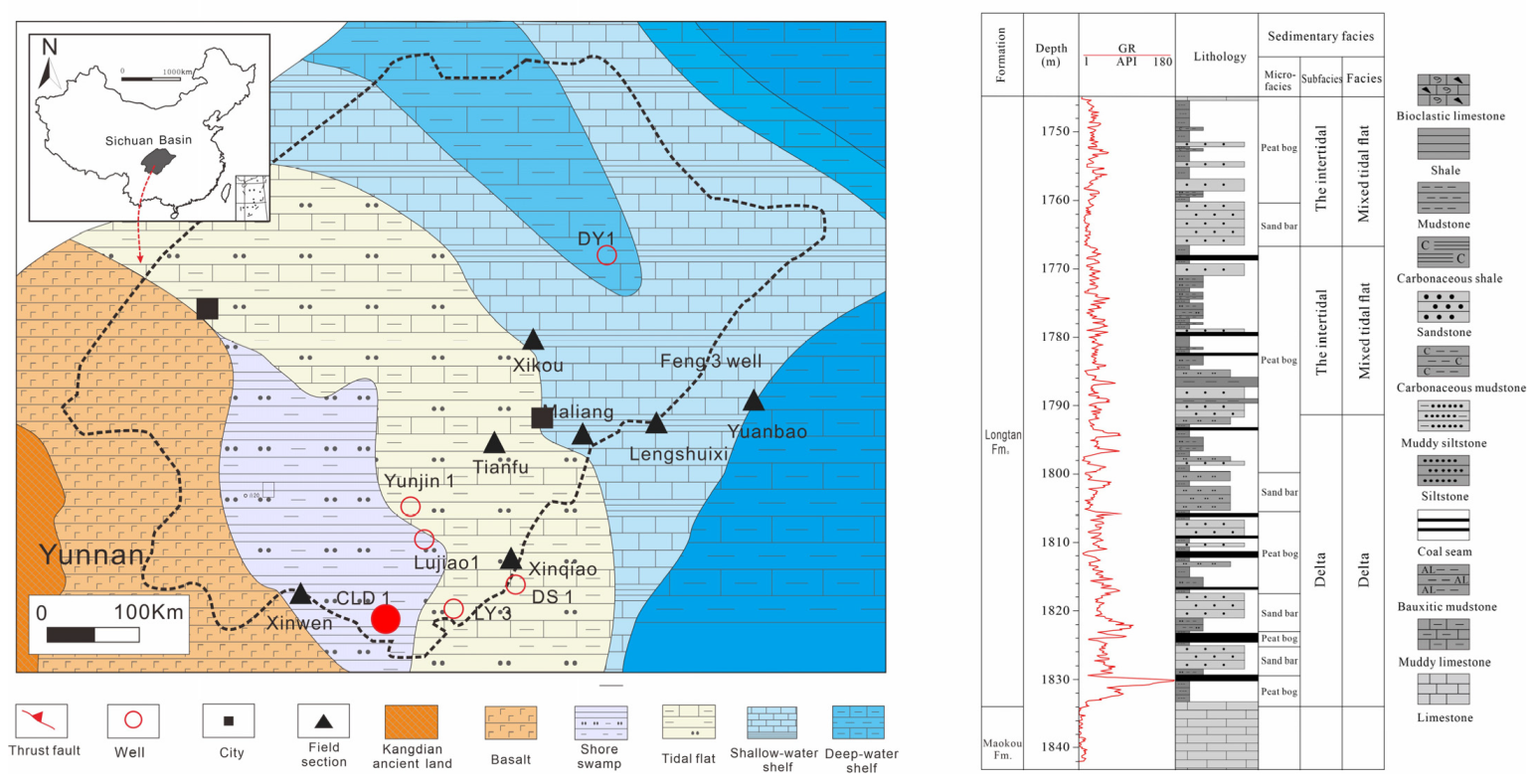
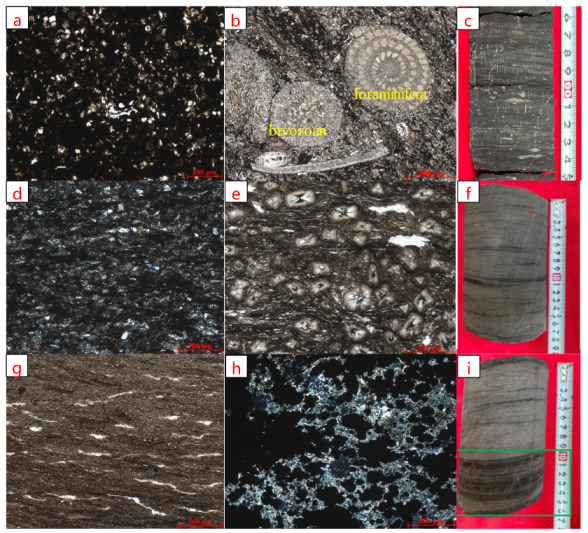

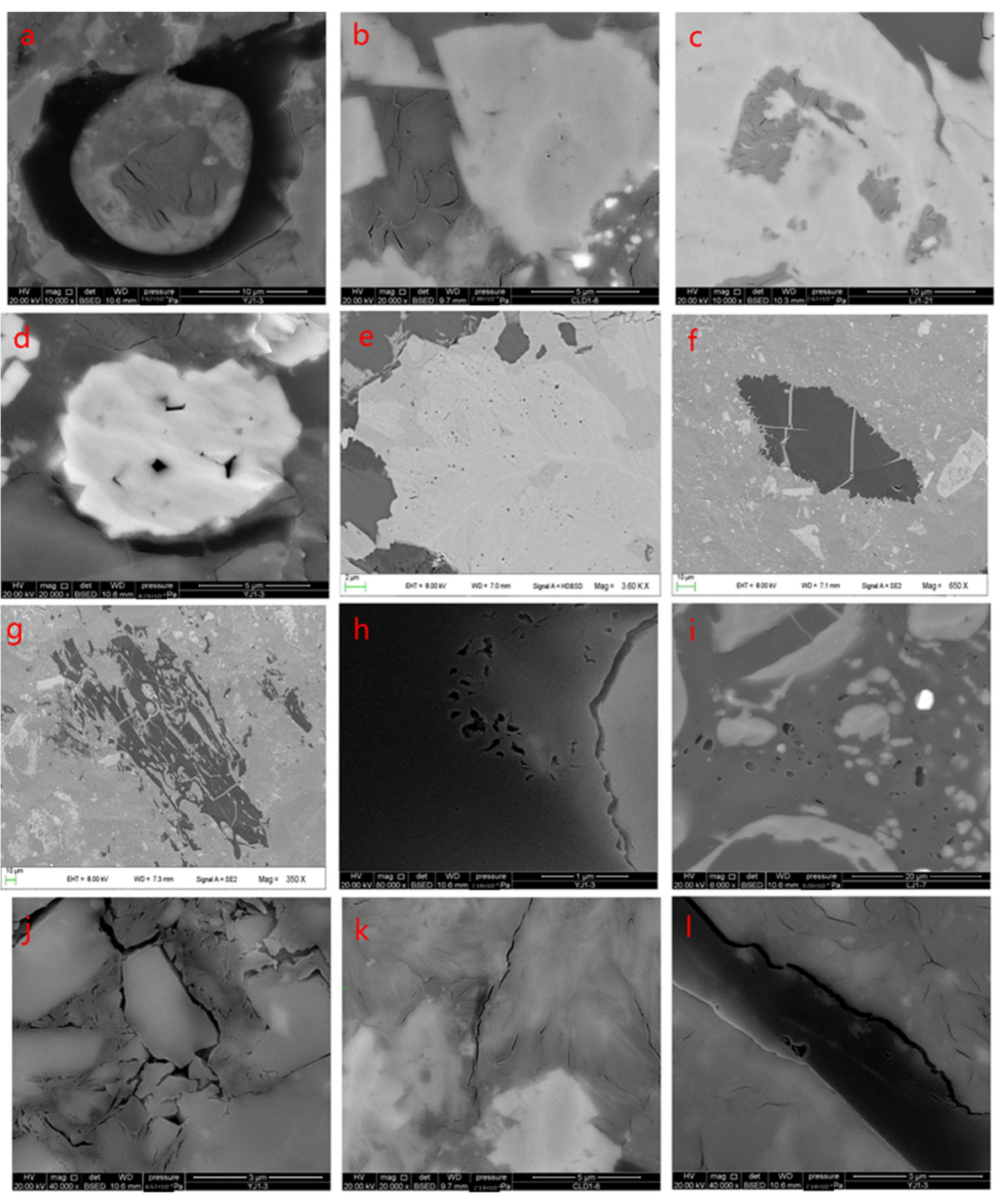
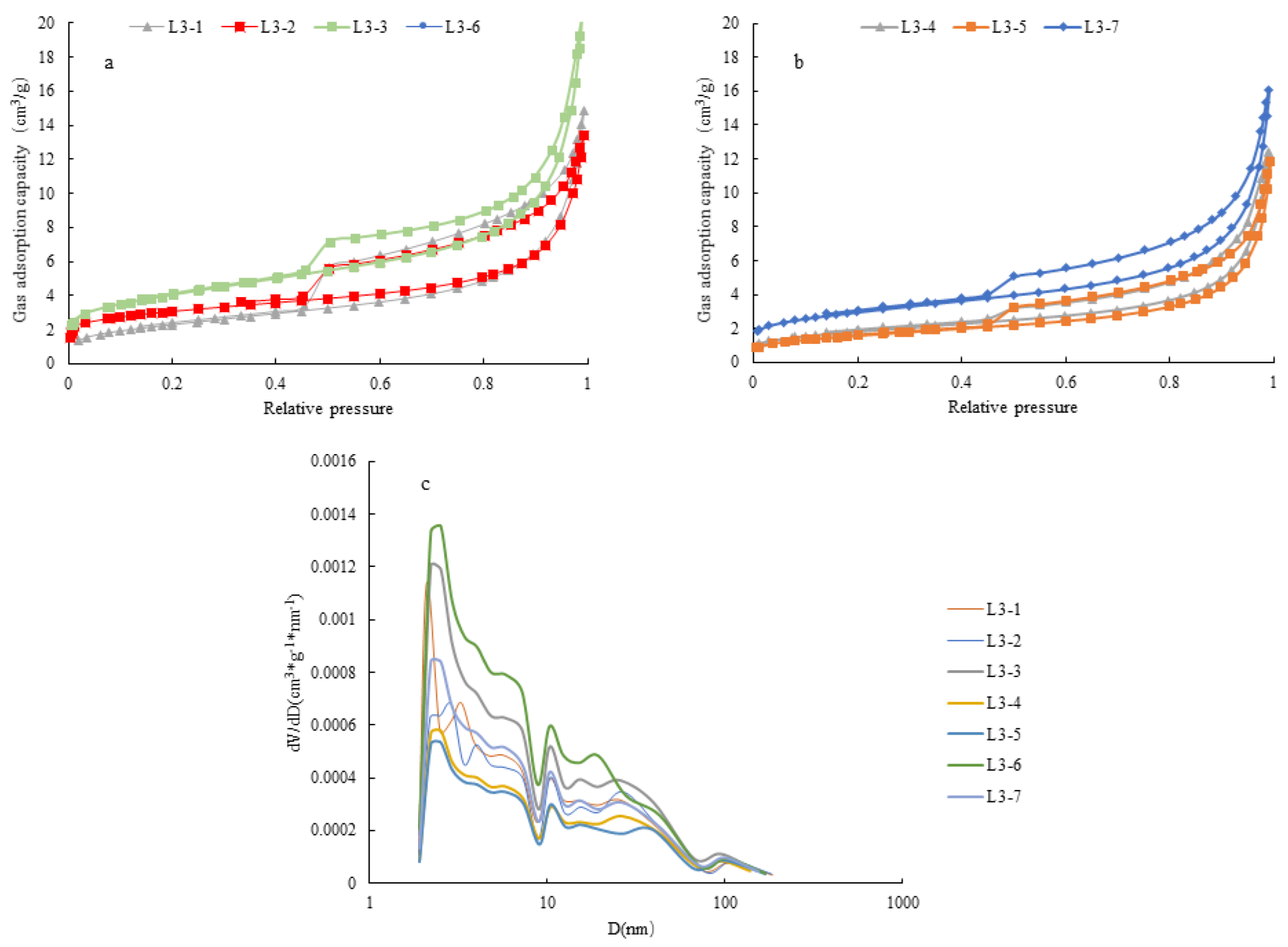
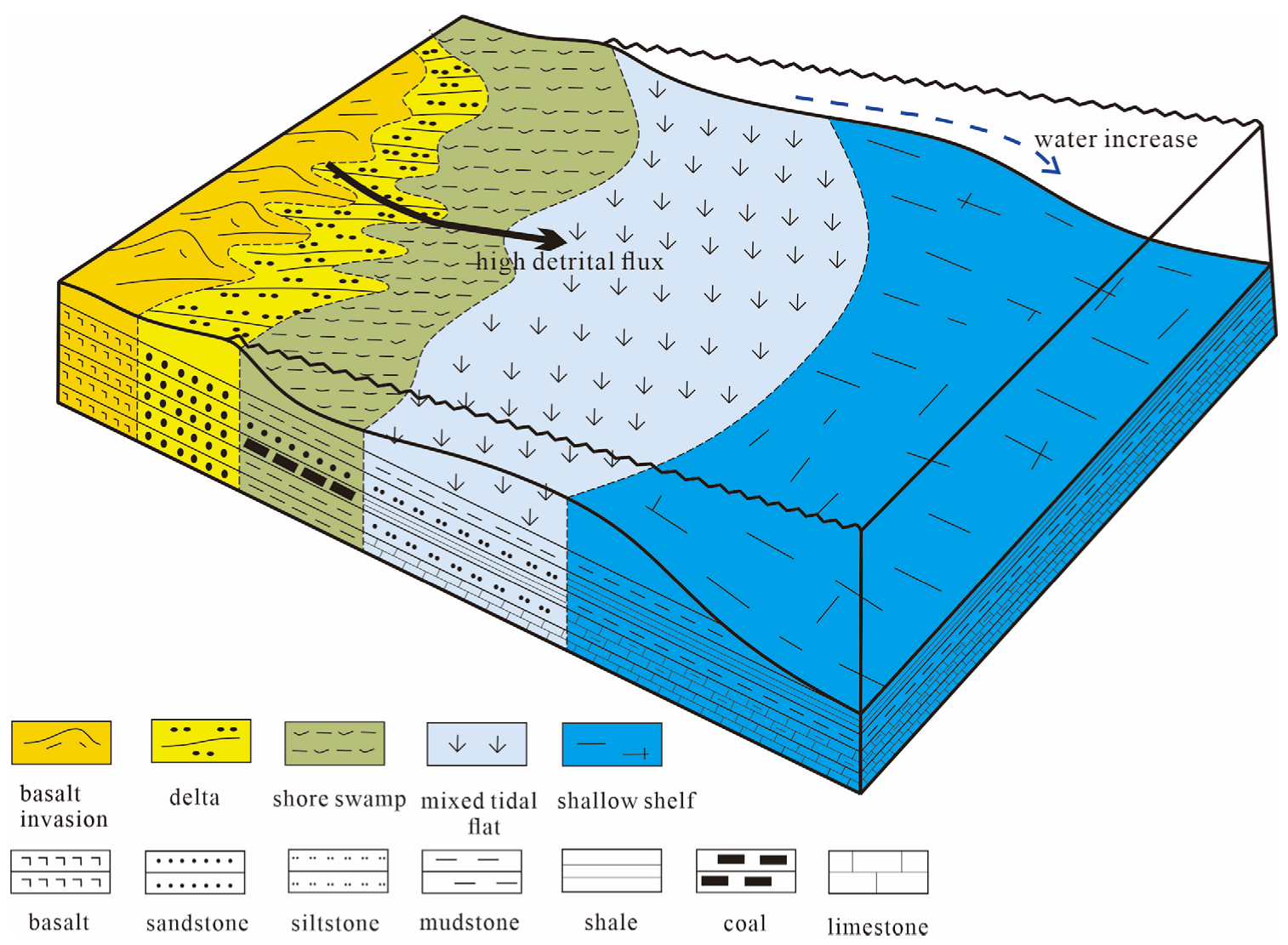
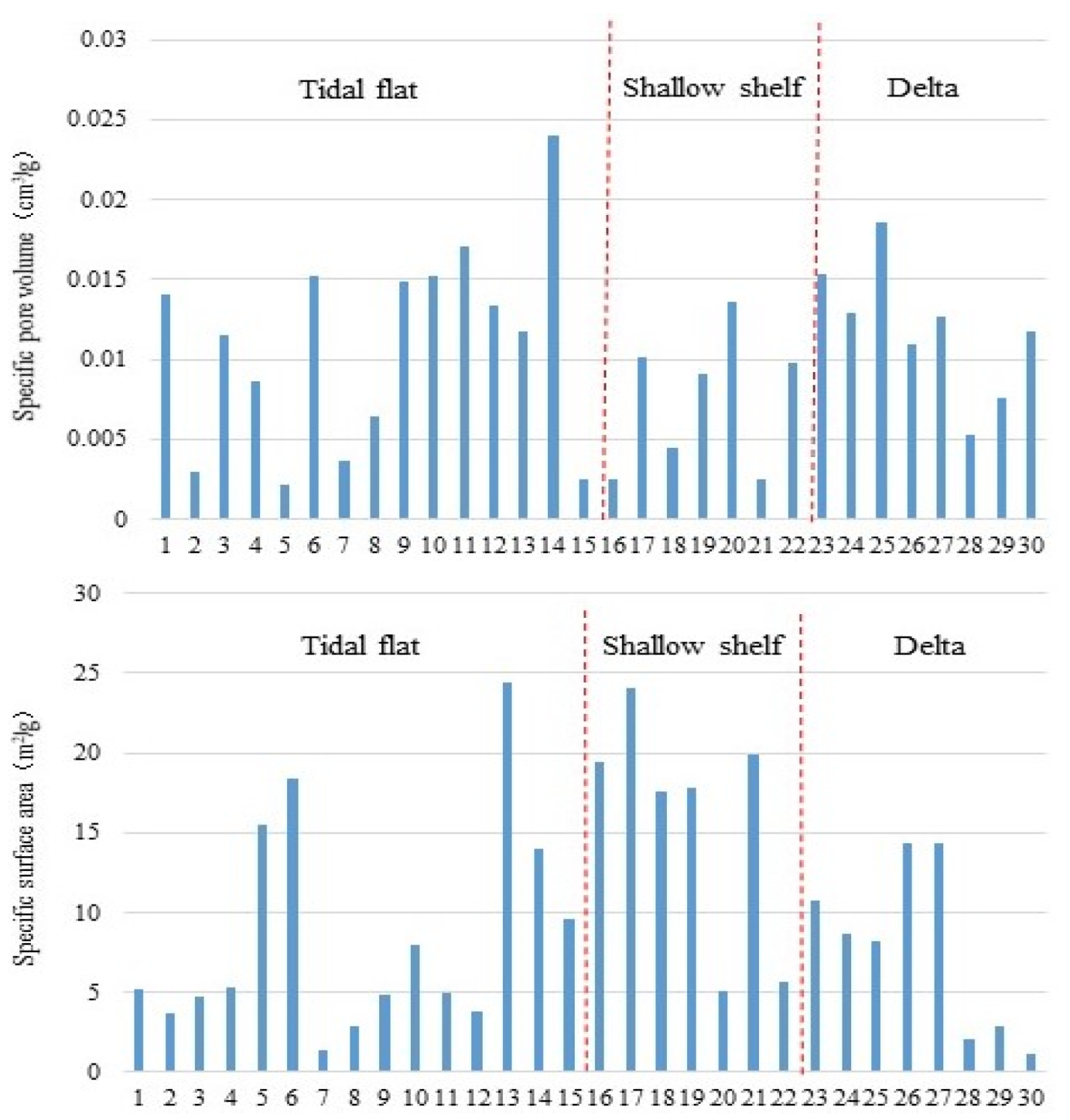
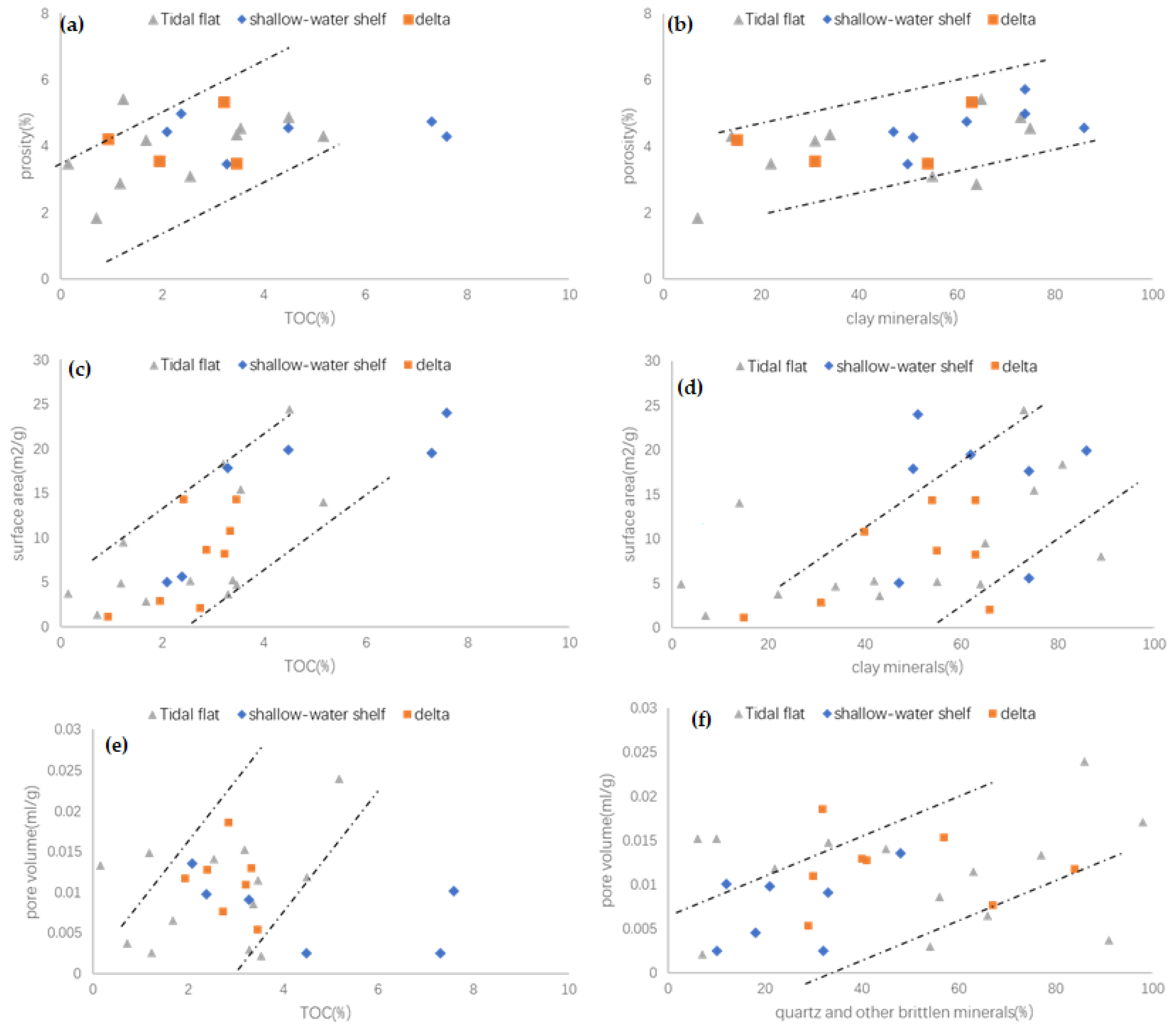
| Sample No. | Lithology | Reflectance | ||||
|---|---|---|---|---|---|---|
| Minimum | Maximum | Average | Standard Deviation | Measured Points | ||
| #3 | Carbonaceous shale | 2.22 | 2.61 | 2.4 | 0.11 | 20 |
| #4 | Calcareous shale | 2.47 | 2.86 | 2.65 | 0.11 | 20 |
| #6 | Shale | 2.52 | 2.85 | 2.69 | 0.09 | 20 |
| #7 | Silty shale | 2.97 | 3.42 | 3.23 | 0.13 | 16 |
| #8 | Shale | 2.96 | 3.41 | 3.26 | 0.11 | 20 |
| #9 | Shale | 3.06 | 3.48 | 3.32 | 0.12 | 15 |
| #12 | Shale | 3.23 | 3.55 | 3.49 | 0.12 | 10 |
| #15 | Silty shale | 3.35 | 3.75 | 3.57 | 0.12 | 16 |
| Sample No. | Depth (m) | Major Element Contents (%) | ||||||||||
|---|---|---|---|---|---|---|---|---|---|---|---|---|
| SiO2 | Al2O3 | MgO | Na2O | K2O | P2O5 | TiO2 | CaO | TFe2O3 | MnO | CIA | ||
| Detection Limits | 0.0335 | 0.0375 | 0.0277 | 0.0021 | 0.0382 | 0.0019 | 0.0333 | 0.0438 | 0.0078 | 0.0138 | ||
| #1 | 3161.23 | 34.56 | 16.43 | 2.66 | 1.07 | 1.28 | 0.37 | 3.18 | 8.08 | 10.18 | 0.19 | 76.96 |
| #2 | 3165.31 | 24.95 | 12.87 | 1.44 | 0.64 | 1.09 | 0.07 | 2.89 | 4.88 | 27.78 | 0.14 | 79.6 |
| #3 | 3168.8 | 21.07 | 3.65 | 1.37 | 0.07 | 0.13 | 0.21 | 0.14 | 4.68 | 9.21 | 0.07 | 90.6 |
| #4 | 3171.97 | 7.33 | 3.02 | 1 | 0.09 | 0.02 | 0.02 | 0.16 | 3.79 | 11.05 | 0.06 | 90.16 |
| #5 | 3173.48 | 42.62 | 24.25 | 0.83 | 1.07 | 1.34 | 0.33 | 4.57 | 0.7 | 6.6 | 0.02 | 84.34 |
| #6 | 3210.79 | 7.26 | 4.8 | 0.09 | 0.16 | 0.06 | 0.03 | 0.42 | 0.5 | 1.06 | 0.01 | 88.77 |
| #7 | 3222.58 | 55.49 | 20.89 | 0.78 | 0.86 | 2.3 | 0.14 | 3.95 | 1.6 | 2.22 | 0.04 | 79.69 |
| #8 | 3239.16 | 10.29 | 7.63 | 0.17 | 0.13 | 0.5 | 0.11 | 0.51 | 8.13 | 12.42 | 0.05 | 88.88 |
| #9 | 3242.08 | 39.78 | 33.09 | 0.12 | 0.19 | 0.13 | 0.03 | 4.91 | 0.15 | 5.82 | 0 | 97.89 |
| #10 | 3243.14 | 32.77 | 27.52 | 0.11 | 0.18 | 0.19 | 0.08 | 4.43 | 0.28 | 15.8 | 0.01 | 97.23 |
| Sample No. | Depth (m) | Trace Element Contents (ug/g) | Elemental Ratio | ||||||||||||||
|---|---|---|---|---|---|---|---|---|---|---|---|---|---|---|---|---|---|
| Li | Be | V | Cr | Co | Ni | Cu | Zn | Ba | Mn | Sn | U | Sr/Cu | V/Cr | EFMo | EFU | ||
| #1 | 3161.23 | 23.89 | 2.72 | 265.03 | 130.2 | 16 | 80.12 | 576.69 | 119.09 | 434.57 | 1408 | 4.06 | 3.72 | 0.912 | 2.04 | 1.41 | 1.27 |
| #2 | 3165.31 | 21.43 | 2.62 | 248.95 | 309.8 | 38.98 | 207.96 | 395.07 | 100.42 | 335.93 | 1131 | 2.97 | 2.8 | 0.985 | 0.8 | 1.76 | 1.22 |
| #3 | 3168.8 | 18.14 | 0.83 | 118.53 | 28.86 | 67.82 | 192.33 | 72.75 | 247.31 | 40.64 | 562 | 1.23 | 1.42 | 3.49 | 4.11 | 10.41 | 2.18 |
| #4 | 3171.97 | 14.02 | 0.67 | 34.02 | 23.78 | 39.43 | 89.13 | 28.02 | 21.08 | 34.16 | 425 | 1.24 | 1.16 | 4.533 | 1.43 | 3.18 | 2.16 |
| #5 | 3173.48 | 59.77 | 4.7 | 357.12 | 145.96 | 52.01 | 123.05 | 204.23 | 133.66 | 455.07 | 143 | 5.11 | 4.18 | 3.731 | 2.45 | 1.18 | 0.96 |
| #6 | 3210.79 | 21.92 | 1.47 | 220.6 | 100.74 | 22.18 | 106.53 | 75.82 | 10.72 | 243.44 | 48 | 1.6 | 1.33 | 1.159 | 2.19 | 2.91 | 1.55 |
| #7 | 3222.58 | 7.15 | 5.57 | 320.96 | 111.54 | 41.82 | 65 | 188.32 | 91.06 | 315.37 | 279 | 5.47 | 4.44 | 3.333 | 2.88 | 1.2 | 1.19 |
| #8 | 3239.16 | 26.1 | 5.02 | 54.7 | 53.96 | 3.54 | 21.13 | 144.54 | 27.14 | 762.65 | 343 | 2.27 | 3.39 | 1.003 | 1.01 | 2.35 | 2.49 |
| #9 | 3242.08 | 217.17 | 3.58 | 1285.76 | 500.56 | 11.7 | 96.62 | 26.91 | 24.6 | 42.21 | 37 | 7.47 | 18.69 | 4.568 | 2.57 | 1.16 | 3.16 |
| #10 | 3243.14 | 240.73 | 3.77 | 977.89 | 391.7 | 18.82 | 113.5 | 99.51 | 47.94 | 45.23 | 76 | 8.94 | 11.37 | 1.678 | 2.5 | 1.09 | 2.31 |
| Lithological combinations | limestone | shale interbed limestone | limestone interbed shale | Lithological combinations | shale | shale interbed silt | silt interbed shale |
 |  |  |  |  |  | ||
| Sedimentary environment | Shallow shelf | Shallow shelf | Shallow shelf | Sedimentary environment | Shore swamp | Mixed tidal flat | Mixed tidal flat |
| Representative well | Cizhu 1 | Zitan 1 | Moxi 53 | Representative well | Tatan 1 | Gaoshi 12 | Chuanlindi 1 |
| Mainly existed layers | 3rd member of Longtan Formation | 3rd member of Longtan Formation | 3rd member of Longtan Formation | Mainly existed layers | 1st member of Longtan Formation | 2nd member of Longtan Formation | 2nd member of Longtan Formation |
| Lithological combinations | limestone interbed coal | shale interbed coal | argillite-shale interbedding | Lithological combinations | silt interbed coal | shale | shale interbed coal |
 |  |  |  |  |  | ||
| Sedimentary environment | Mixed tidal flat | Mixed tidal flat | Mixed tidal flat | Sedimentary environment | Shore swamp | Mixed tidal flat | Shore swamp |
| Representative well | Dingshan 1 | Dingshan 1 | Gaoshi 32 | Representative well | Luoguan 1 | Yunjin 1 | Lujiao 1 |
| Mainly existed layers | 2nd member of Longtan Formation | 1st member of Longtan Formation | 3rd member of Longtan Formation | Mainly existed layers | 3rd member of Longtan Formation | 1st member of Longtan Formation | 1st member of Longtan Formation |
Disclaimer/Publisher’s Note: The statements, opinions and data contained in all publications are solely those of the individual author(s) and contributor(s) and not of MDPI and/or the editor(s). MDPI and/or the editor(s) disclaim responsibility for any injury to people or property resulting from any ideas, methods, instructions or products referred to in the content. |
© 2023 by the authors. Licensee MDPI, Basel, Switzerland. This article is an open access article distributed under the terms and conditions of the Creative Commons Attribution (CC BY) license (https://creativecommons.org/licenses/by/4.0/).
Share and Cite
Chen, Y.; Shi, X.; Xu, H.; Cao, Q.; Pei, X.; Wu, W.; Wang, L.; Yang, X. Study on the Sedimentary Environments and Its Implications of Shale Reservoirs for Permian Longtan Formation in the Southeast Sichuan Basin. Minerals 2023, 13, 689. https://doi.org/10.3390/min13050689
Chen Y, Shi X, Xu H, Cao Q, Pei X, Wu W, Wang L, Yang X. Study on the Sedimentary Environments and Its Implications of Shale Reservoirs for Permian Longtan Formation in the Southeast Sichuan Basin. Minerals. 2023; 13(5):689. https://doi.org/10.3390/min13050689
Chicago/Turabian StyleChen, Yana, Xuewen Shi, Hao Xu, Qian Cao, Xiangyang Pei, Wei Wu, Linqi Wang, and Xue Yang. 2023. "Study on the Sedimentary Environments and Its Implications of Shale Reservoirs for Permian Longtan Formation in the Southeast Sichuan Basin" Minerals 13, no. 5: 689. https://doi.org/10.3390/min13050689
APA StyleChen, Y., Shi, X., Xu, H., Cao, Q., Pei, X., Wu, W., Wang, L., & Yang, X. (2023). Study on the Sedimentary Environments and Its Implications of Shale Reservoirs for Permian Longtan Formation in the Southeast Sichuan Basin. Minerals, 13(5), 689. https://doi.org/10.3390/min13050689







